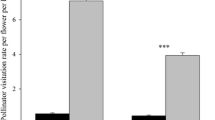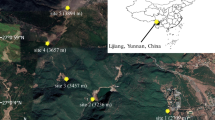Abstract
Decreases in floral density can disrupt mutualistic interactions between plants and their pollinators, and decrease reproductive success. I addressed the relationship between floral density and plant reproductive success using two experimental approaches: a pollen supplementation experiment in 12 populations of Trillium grandiflorum that naturally varied in floral density, and a transplant experiment in which floral density was manipulated in plots at four experimental sites. In the pollen supplementation experiments, the degree of pollen limitation, in terms of fruit set and seed set, decreased with floral density. Further, in the experimental sites, plant reproductive success increased asymptotically with floral density. These results demonstrate the value of simultaneously conducting experiments in both experimental sites and natural populations to understand how population density influences plant reproductive success. Factors that reduce the density of this perennial herb, such as habitat fragmentation and herbivory by white-tailed deer (Odocoileus virginianus), should be expected to limit its reproduction.


Similar content being viewed by others
References
Agren J (1996) Population size, pollinator limitation, and seed set in the self-incompatible herb Lythrum salicaria. Ecology 77:1779–1790
Allee WC, Emerson AE, Park O, Park T, Schmidt KP (1949) Principals of animal ecology. Saunders, Philadelphia, Penn.
Anderson RC (1994) Height of white-flowered trillium (Trillium grandiflorum) as an index of deer browsing intensity. Ecol Appl 4:104–109
Augustine DL, Frelich LE (1998) Effects of white-tailed deer on populations of an understory forb in fragmented deciduous forests. Conserv Biol 12:995–1004
Baker AM, Barrett SCH, Thompson JD (2000) Variation of pollen limitation in the early flowering Mediterranean geophyte Narcissus assoanus (Amaryllidaceae). Oecologia 124:529–535
Broyles SB, Sherman-Broyles SL, Rogati P (1997) Evidence of outcrossing in Trillium erectum and Trillium grandiflorum (Liliaceae). J Hered 88:325–329
Buchmann SK, Nabhan GP (1996) The forgotten pollinators. Island, Washington D.C.
Byers DL, Meagher TR (1992) Mate availability in small populations of plant species with homomorphic sporophytic self-incompatibility. Heredity 68:353–359
Campbell DR (1986) Predicting plant reproductive success from models of competition for pollination. Oikos 47:257–266
Carlsson-Graner UT, Elmqvist J, Agren J, Gardfjell H, Ingvarsson P (1998) Floral sex ratios, disease and seed set in dioecious Silene dioica. J Ecol 86:79–91
Case FW Jr, and Case RB (1997) Trilliums. Timber, Portland, Or.
Courchamp F, Clutton-Brock T, Grenfell B (1999) Inverse density dependence and the Allee effect. Trends Ecol Evol 14:405–410
Dieringer G (1992) Pollinator effectiveness and seed set in populations of Agalinis strictifolia (Scrophulariaceae). Am J Bot 79:1018–1023
Dudash MR, Fenster CB (1997) Multiyear study of pollen limitation and cost of reproduction in the iteroparous Silene virginica. Ecology 78:484–493
Feinsinger P, Murray G, Kinsman S, Busby WH (1986) Floral neighborhood and pollination success in four hummingbird-pollinated cloud forest plant species. Ecology 67:449–464
Fritz A-L, Nilsson LA (1994) How pollinator-mediated mating varies with population size in plants. Oecologia 100:451–462
Goodwillie C (2001) Pollen limitation and the evolution of self-compatibility in Linanthus (Polemoniaceae). Int J Plant Sci 162:1283–1292
Griffin SR and Barrett SCH (2002). Factors affecting low seed:ovule ratios in a spring woodland herb, Trillium grandiflorum (Melanthiaceae). Int J Plant Sci 163:581–590
Groom MJ (1998) Allee effects limit population viability of an annual plant. Am Nat 153:487–496
Hackney EE, McGraw JB (2001) Experimental demonstration of an Allee effect in American ginseng. Conserv Biol 15:129–136
Hilborn R, Mangel M (1997) The ecological detective: confronting models with data. Princeton University Press, Princeton, N.J.
House SM (1993) Pollination in a population of dioecious rain forest trees. Oecologia 96:555–561
Irwin RE (2000) Morphological variation and female reproductive success in two sympatric Trillium species: Evidence for phenotypic selection in Trillium erectum and Trillium grandiflorum (Liliaceae). Am J Bot 87:205–214
Irwin RE (2001) Field and allozyme studies investigating optimal mating success in two sympatric spring-ephemeral plants, Trillium erectum and T. grandiflorum. Heredity 87:178–189
Jules ES (1998) Habitat fragmentation and demographic change for a common plant: Trillium in old-growth forests. Ecology 79:1645–1656
Kalisz S, Hanzawa FM, Tonsor SJ, Thiede DA, Voigt S (1999) Ant-mediated seed dispersal alters pattern of relatedness in a population of Trillium grandiflorum. Ecology 80:2620–2634
Karrenberg S, Jensen K (2000) Effects of pollination and pollen source on the seed set of Pedicularis palustris. Folia Geobot 35:191–202
Klinkhamer PGL, de Jong TJ (1990) Effects of plant size, plant density and sex differential nectar reward on pollinator visitation in the protandrous Echium vulgare (Boraginaceae). Oikos 57:399–405
Knight TM (2003a) Effects of herbivory and its timing across populations of Trillium grandiflorum (Liliaceae). Am J Bot 90:1207–1214
Knight TM (2003b) The effects of herbivory and pollen limitation on the population dynamics of Trillium grandiflorum. PhD thesis, University of Pittsburgh, Penn.
Kunin WE (1993) Sex and the single mustard: Population density and pollinator behavior effects on seed-set. Ecology 74:2145–2160
Kunin WE (1997a) Population biology and rarity: On the complexity of density-dependence in insect-plant interactions. In: Kunin WE, Gaston KJ (eds) The biology of rarity: causes and consequences of rare-common differences. Chapman and Hall, London, pp 150–169
Kunin WE (1997b) Population size and density effects in pollination: Pollinator foraging and plant reproductive success in experimental arrays of Brassica kaber. J Ecol 85:225–234
Larson BMH, Barrett SCH (1999) The ecology of pollen limitation in buzz-pollinated Rhexia virginica (Melastomataceae). J Ecol 87:371–381
Mitchell RJ (1997) Effects of pollination intensity on Lesquerella fendleri seed set: Variation among plants. Oecologia 109:382–388
Moody-Weis JM, Heywood JS (2001) Pollination limitation to reproductive success in the Missouri evening primrose, Oenothera macrocarpa (Onagraceae). Am J Bot 88:1615–1622
Mustajarvi K, Siikamaki P, Rytkonen S, Lammi A (2001) Consequences of plant population size and density for plant-pollinator interactions and plant performance. J Ecol 89:80–87
Ramsey M, Vaughton G (2000) Pollen quality limits seed set in Burchardia umbellata (Colchicaceae). Am J Bot 87:845–852
Sage TL, Griffin SR, Pontieri V, Drobac P, Cole WW, Barrett SCH (2001) Stigmatic self-incompatibility and mating patterns in Trillium grandiflorum and Trillium erectum. Ann Bot 88:829–841
Santandreu M, Lloret F (1999) Effect of flowering phenology and habitat on pollen limitation in Erica multiflora. Can J Bot 77:734–743
Stephens PA, Sutherland WJ (1999) Consequences of the Allee effect for behaviour, ecology and conservation. Trends Ecol Evol 14:401–405
Stephenson AG (1981) Flower and fruit abortion: Proximate causes and ultimate functions. Annu Rev Ecol Syst 12:253–279
Steven JC, Peroni PA, Rowell E (1999) The effects of pollen addition on fruit set and sex expression in the andromonoecious herb Horsenettle (Solanum carolinense). Am Midl Nat 141:247–252
Steven JC, Rooney TP, Boyle OD, Waller DM (2003) Density-dependent pollinator visitation and self-incompatibility in upper Great Lakes populations of (Trillium grandiflorum). J Torrey Bot Soc 130:23–29
SYSTAT (1999) SYSTAT version 9. SPSS Institute, Chicago, Ill.
Widen B (1993) Demographic and genetic effects on reproduction as related to population size in a rare, perennial herb, Senecio integrifolius. Biol J Linn Soc 50:179–195
Acknowledgments
I thank T-L. Ashman, A. Case, J. Chase, S. Kalisz, R. Relyea, J. Steets and S. Tonsor for discussions and comments, J. Butzler, J. Chase, J. Dunn and J. Kauffman for help in the field, and B. Casper and two anonymous reviewers for helpful suggestions. This research was supported by McKinley and Darbarker research funds, Botany in Action (Phipps Conservatory and Botanical Garden), the University of Florida Foundation, and the NSF (DEB-0105000). This is Pymatuning Laboratory of Ecology Publication 142.
Author information
Authors and Affiliations
Corresponding author
Rights and permissions
About this article
Cite this article
Knight, T.M. Floral density, pollen limitation, and reproductive success in Trillium grandiflorum . Oecologia 137, 557–563 (2003). https://doi.org/10.1007/s00442-003-1371-8
Received:
Accepted:
Published:
Issue Date:
DOI: https://doi.org/10.1007/s00442-003-1371-8




